Ansibl Read Each Line File Into Array
Ansible Automation is really powerful with its filters and functions. Information technology does provide various string manipulation and formatting filters from Jinja and Python.
In this article, nosotros are going to see how to Split strings in Ansible.
Every bit you might have already guessed, Ansible provides filters/functions to ease our job.
Ansible split up is a filter based on Python Split to split based on a character (separator)
We will encounter examples of Ansible Carve up filters with different datasets like Simple strings, Lists, Dictionaries etc.
Ansible Separate Examples
When it comes to string formatting, Splitting the cord into multiple parts based on the separator position has always been a key chemical element.
Let'southward say yous have a CSV file and yous want to convert the CSV(comma separated values) into a list of values like sequence or array like this
sarav,9876543210,[email protected] =>to=> ['sarav','9876543210','[electronic mail protected]']
Now you tin can simply use their index value to get the value like proper name, mobile or electronic mail id
Or let's imagine y'all accept a lot of business organization email IDs and you are interested in merely the domain names
[email protected] [email protected] [email protected] [email protected]
With python, you lot can simply practise information technology like this
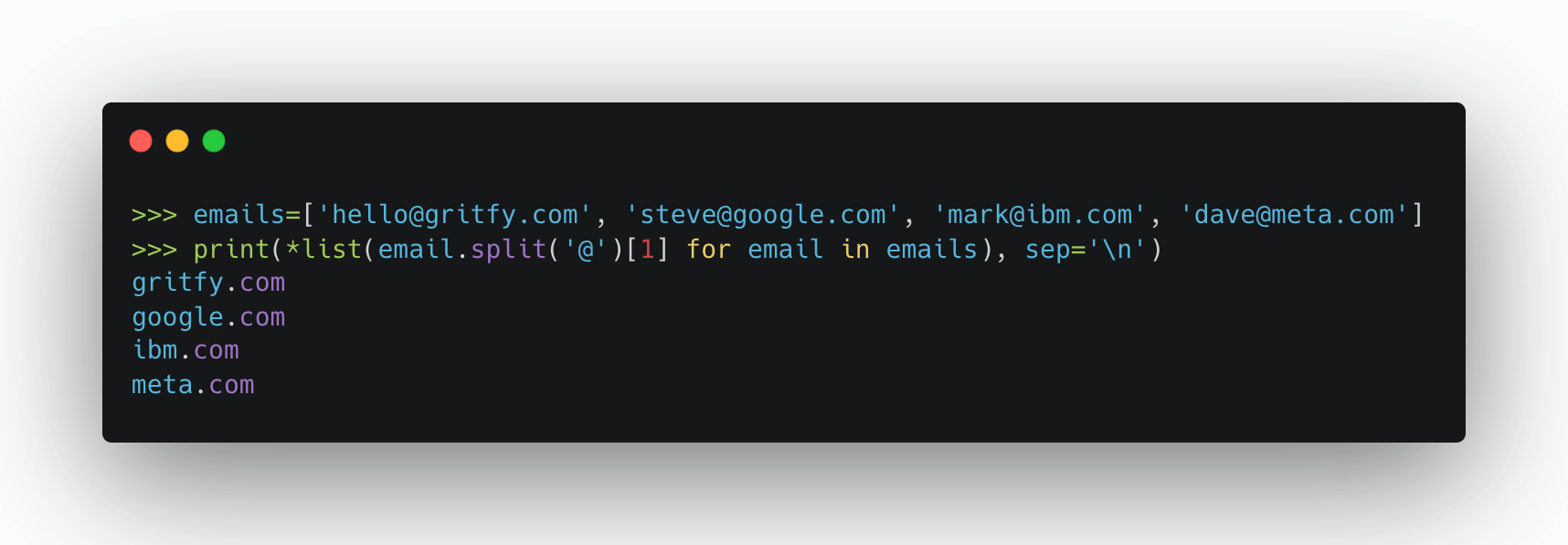
Let usa see how to do the same with Ansible at present.
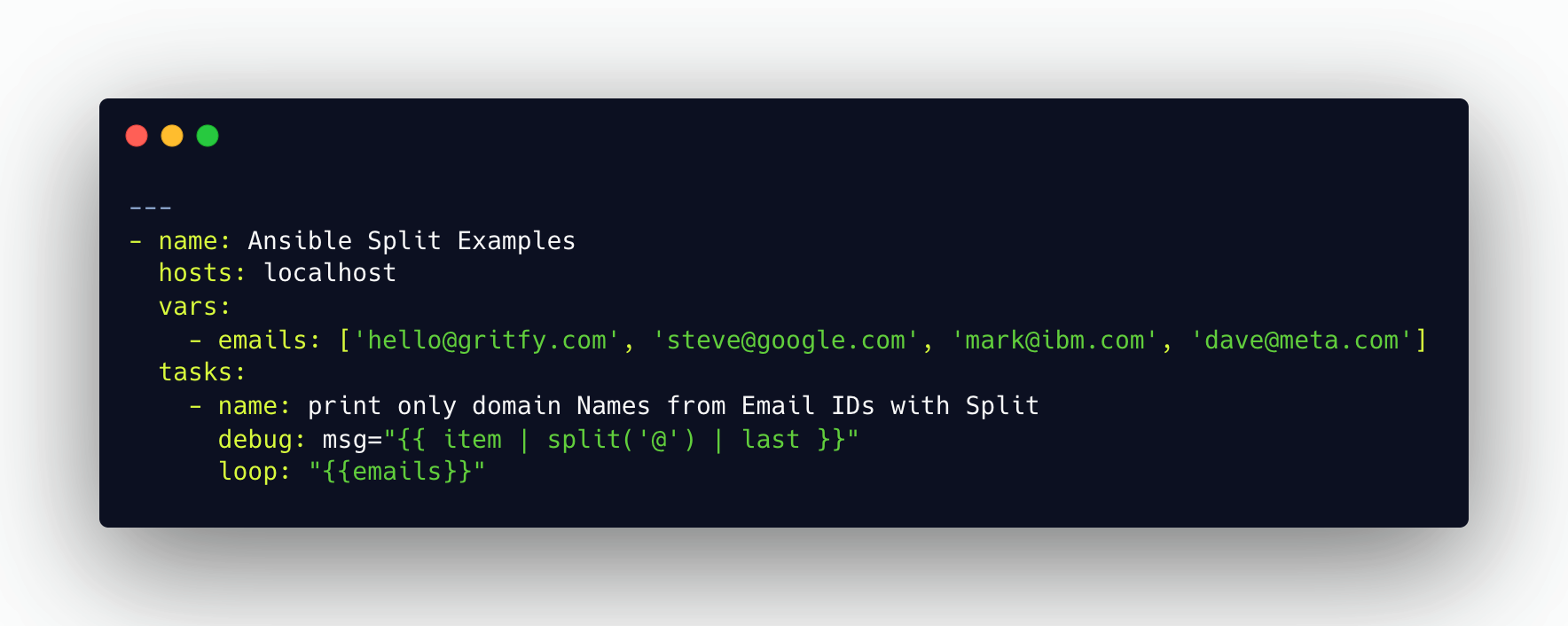
Not simply ane, There are multiple ways to practice this in Ansible. hither is one more
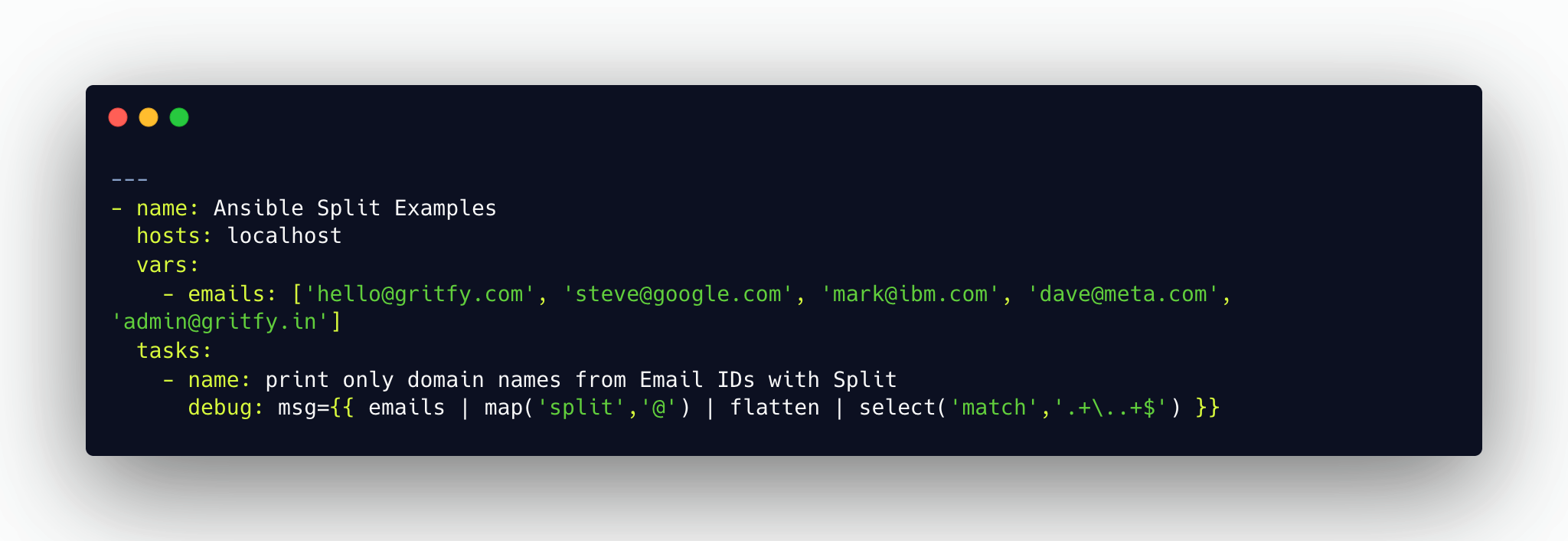
Let us go through the source lawmaking of these items and much more, to understand the Ansible Split filter better.
Example1: Ansible Separate Simple String
Splitting a simple string in Ansible with a Dissever filter is no big job.
All you need to use is a uncomplicated split up followed past the cord. Here is a quick example
--- - proper name: Ansible Divide Examples hosts: localhost tasks: - name: Split Simple String Example debug: msg={{ '[electronic mail protected]'|split('@')}} Here is the execution and the output
I know this is a really elementary example. Move on to some real-fourth dimension examples down beneath.
Example2: Ansible Divide with loop – To process list of strings
In this example, we have a list of e-mail IDs stored in a variable called emails which is beingness sent to the loop iteration
For those who are familiar with with_items you tin use that too. Each element on the list can exist accessed past the variable particular
the detailvariable is existence used within the debug msgstatement where we are applying the splitbeyond each email ID
The result of the split would be a list with 2 items. which can exist accessed using Ansible special filters beginning and concluding
-
starting timeis to get the first element of the list more similarlist[0] -
lastis to get the last element of the list more likelist[-1]orlist[len(list)-1]
In our instance, we know prior that in that location would exist only 2 values in the returned list of split. so nosotros tin can apply the last here to get the domain names every bit our seperator is @
--- - name: Ansible Split Examples hosts: localhost vars: - emails: ['[email protected]', '[e-mail protected]', '[email protected]', '[e-mail protected]', '[email protected]'] tasks: - name: print simply domain Names from Email IDs with Split debug: msg="{{ item | split('@') | last }}" loop: "{{emails}}" Example3: Ansible Split with Map – To process Nested Lists
Here is the source lawmaking of the second playbook
--- - name: Ansible Split up Examples hosts: localhost vars: - emails: ['[e-mail protected]', '[electronic mail protected]', '[email protected]', '[email protected]', '[electronic mail protected]'] tasks: - proper name: print simply domain names from Email IDs with Split debug: msg={{ emails | map('split','@') | flatten | select('friction match','.+\..+$') }} The reason we are using the map filter hither is that we want to utilise the split office on the elements of the list. not on the list itself.
If it is a simple string that nosotros desire to split we can just do it like this
msg: "{{ '[email protected]' | split('@') | last }}" merely our email ids are stored inside the list and in our terminal example, we have iterated over the listing emails and passed each email id to for the split processing with item
Now instead of using loop we are using Ansible Map filter
To know more almost the Ansible map refer to our dedicated article here.
flatten is used here to catechumen the list of lists ( nested lists ) into a single listing.
Ideally, the event of the map and split would exist like this, [[],[],[],[]]a Nested list/array
"msg": [ [ "hello", "gritfy.com" ], [ "steve", "google.com" ], [ "mark", "ibm.com" ], [ "dave", "meta.com" ], [ "admin", "gritfy.in" ] ] }
and with flatten it would become similar this, A single listing with multiple values.
"msg": [ "hi", "gritfy.com", "steve", "google.com", "mark", "ibm.com", "dave", "meta.com", "admin", "gritfy.in" ]
At present our job is to get the elements matching a regex pattern *.[org|com] etc. That's, where nosotros are using select
select is a jinja2 filter that helps usa to select the matching item from the list, with select we are going to employ another filter named match to perform the regular expression pattern matching.
Our regular expression is this .+\..+$ to select the domain from the listing. you can endeavor this pattern in regex101.com to find out what it does ( if you are new to regex)
The consequence of this second playbook would exist like this
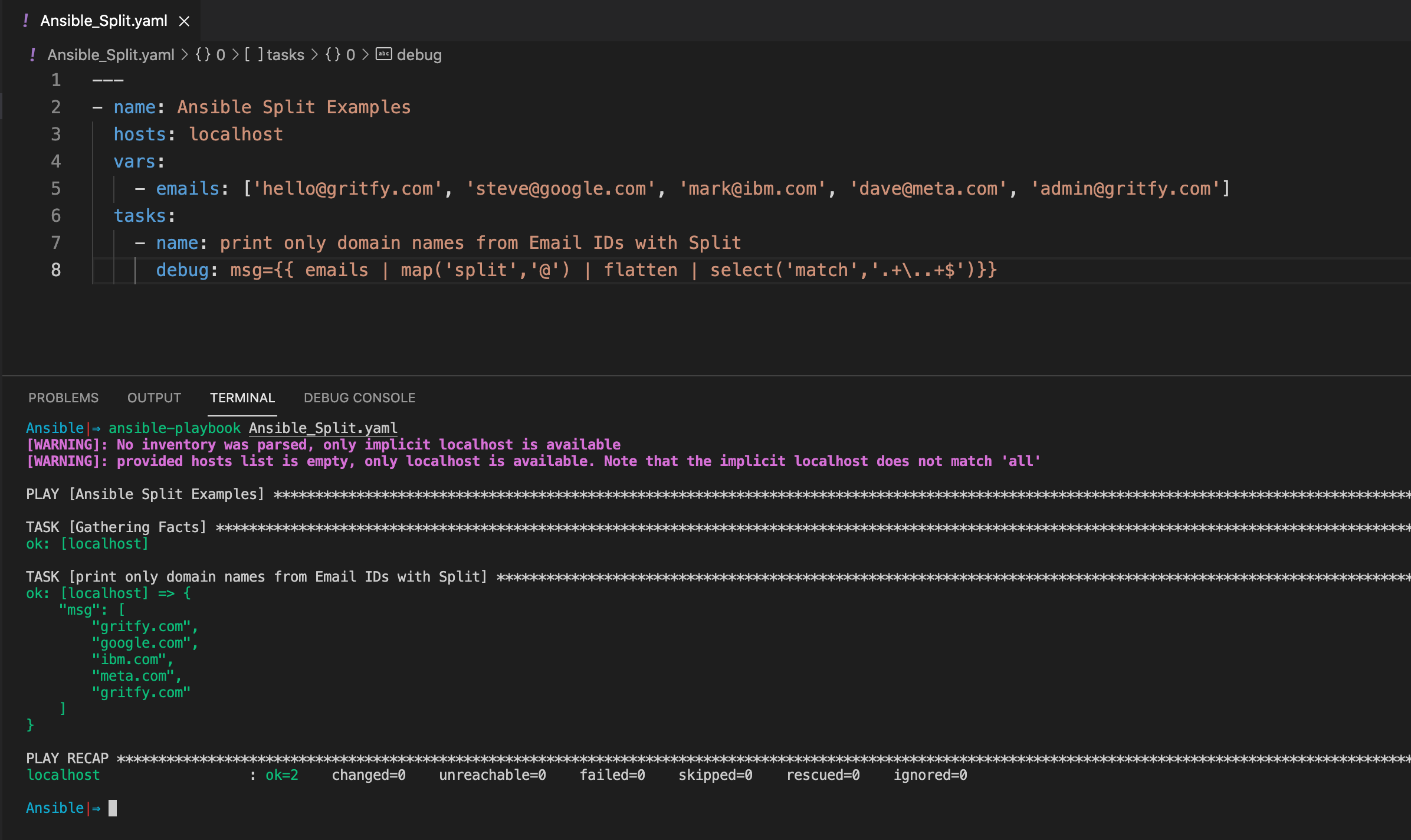
Much simpler and slap-up. everything is washed in a single line with no loop.
Example4: Ansible Divide – With File Content
Every bit part of this example, we are going to read a file named /etc/passwd from the filesystem and process it line by line and split based on separator
--- - name: Ansible Split Examples hosts: localhost vars: - usernames : [] tasks: - proper noun: impress just domain names from Electronic mail IDs with Split set_fact: usernames: '{{ usernames + [ particular | split(":") | starting time ] }}' loop: "{{ lookup('file', '/etc/passwd').splitlines() | select('match','^(?!#)')}}" - debug: var=usernames we have used a few functions/filters here, allow us decode each one of them
to begin with, let us start with loop expression
"{{ lookup('file', '/etc/passwd').splitlines() | select('match','^(?!#)')}}" Here the
-
lookupfilter is used to read the content of the files -
splitlinesis to split the file content line past line -
selectfilter to execute another filter to select a matching element from the sequence. ( it is different from selectattr) -
matcha filter existence executed by select. to perform regular expression matching
Hither is the output of this playbook.
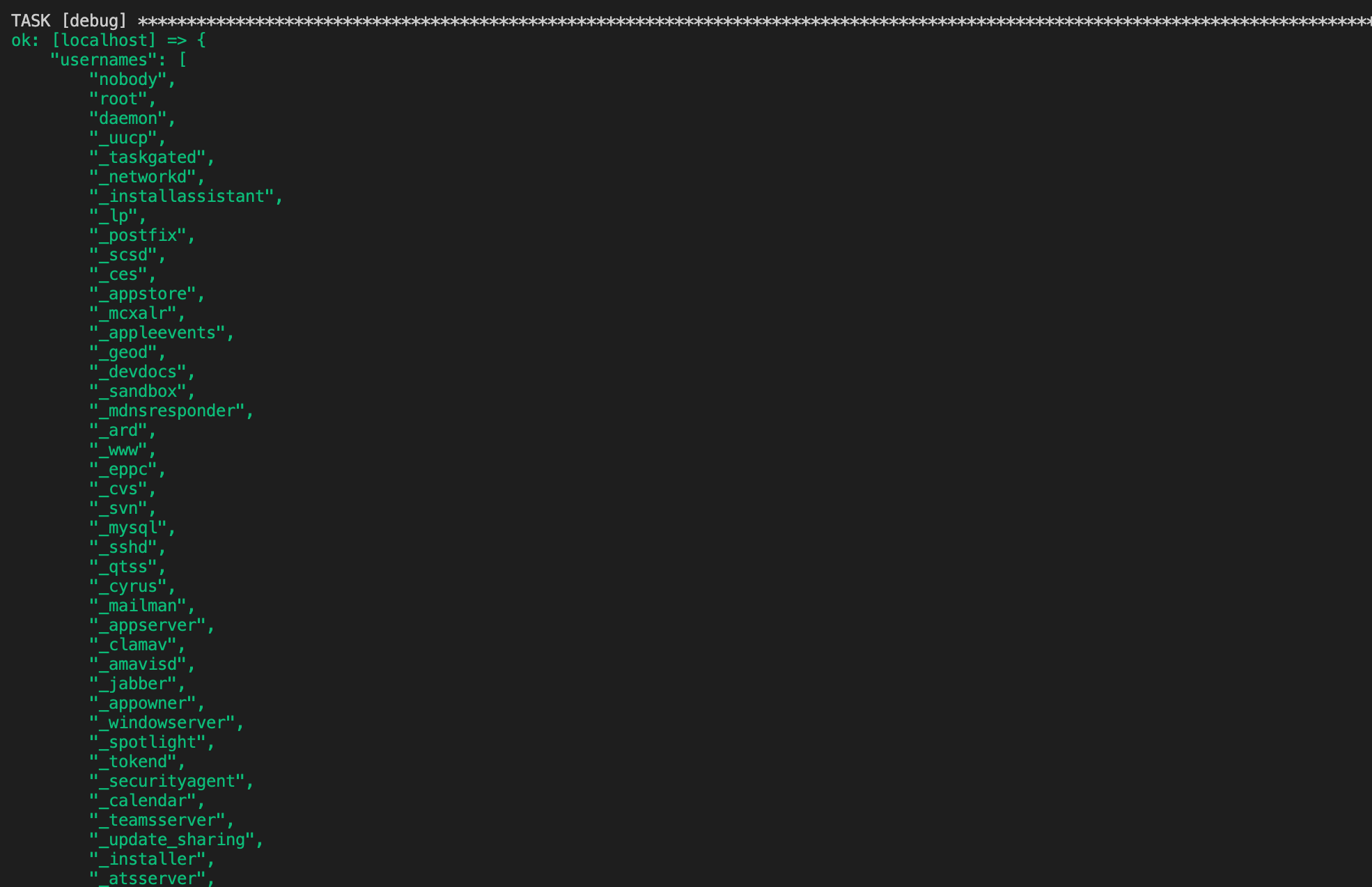
Conclusion
In this detailed article nearly Ansible Split. I tried to encompass not just the simple split up but also to cover how tin can you lot utilize it with dist, List etc
we take also talked about various other filters and topics like
- How to read a file content into Ansible split into lines
- Selecting elements from the LIST using
select - Regular expression pattern matching using
match - How to use
loopand iteration statements - How to use expressions with
loopetc.
Hope y'all would find this article helpful.
Cheers
Sarav AK
![]()
Follow us on Facebook or Twitter
For more than practical videos and tutorials. Subscribe to our channel
Find me on Linkedin My Profile
For whatever Consultation or to hire u.s.a. [email protected]
If yous similar this article. Testify your Support! Buy me a Coffee.
Signup for Exclusive "Subscriber-only" Content
Source: https://www.middlewareinventory.com/blog/ansible-split-examples/
0 Response to "Ansibl Read Each Line File Into Array"
Post a Comment